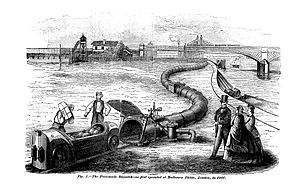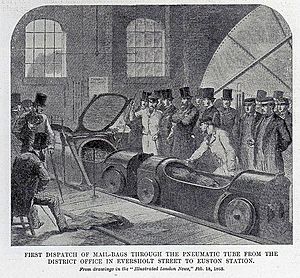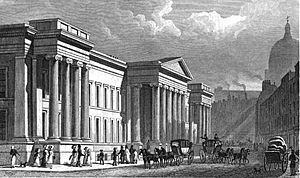London Pneumatic Despatch Company facts for kids
The London Pneumatic Despatch Company was a special company started on June 30, 1859. Its job was to create and run an underground railway system in London. This system was designed to carry mail, packages, and small goods using air pressure. It was like a giant vacuum tube! The company operated this unique system between 1863 and 1874.
Contents
How the Idea Started
Back in the 1850s, Sir Rowland Hill, who worked for the General Post Office (the main mail service in the UK), asked engineers to see if a system using air tubes could work. They thought it was possible but would cost a lot of money. So, the idea didn't go forward at that time.
Then, in 1859, two engineers named Thomas Webster Rammell and Josiah Latimer Clark suggested building an underground tube network. They believed it would help send messages and packages much faster around central London.
The company was officially formed in 1859. It aimed to raise a lot of money to build this new system. With some initial funding, the company started testing its technology. They built a small test track at a factory in Birmingham.
The first big test happened in Battersea in the summer of 1861. They installed a single tube that was about 452 yards (or 413 meters) long. It even had curves and slopes! Inside the tube, they laid a narrow railway track. Special wheeled containers, called capsules, were made to fit snugly. They had rubber flaps to create an airtight seal. A powerful steam engine with a huge fan, 21 feet (about 6.4 meters) wide, provided the air power. These capsules could weigh up to 3 tonnes (that's like a small truck!) and travel as fast as 40 miles per hour (60 km/h).
How the System Worked
The first permanent line was built between Euston railway station and the North West District Post Office in Eversholt Street. This was a distance of about a third of a mile (around 530 meters). After testing began on January 15, 1863, the system officially started working on February 20, 1863.
A single capsule could carry up to 35 bags of mail! It made the short trip between the two stations in just one minute. The system ran 13 times a day. The Post Office paid a small fee to use the service, which encouraged them to try out this new technology.
A journalist wrote about the first system at Euston, describing how it worked:
Imagine a tube opening near Euston Square, with special carriages ready to go inside. When a bell rings, it means a mail train has arrived. A steam engine starts working quickly, powering a huge fan that's 21 feet wide. This fan sucks in air at its center and pushes it out at its edges. This strong air flow is then directed into the big pneumatic tube. This is how the carriages are pushed or pulled along their underground path. A mail-guard puts two or three mail-bags into the iron carriages, which are then pushed into the tube. The airtight door closes, and you hear them rumbling away underground at about 20 miles an hour. A bell connected to an electric telegraph warns that a carriage is about to return. It was pushed by air pressure, but it's pulled back by suction. The suction pipe opens, and soon you hear a hollow rumbling, and out shoots the carriage, ready for more bags!
The company wanted to build more lines across London. They started building a new line from Euston to Holborn in September 1863. The first 'trains' on this new line ran on October 10, 1865. To show how it worked, the company's chairman, Richard Temple-Grenville, 3rd Duke of Buckingham and Chandos, even rode in one of the capsules from Holborn to Euston!
Another line was being built from Holborn to Gresham Street, passing by the main General Post Office building. By 1866, a part of this tube was finished. Construction continued, and the line reached the General Post Office in 1869. Capsules from the General Post Office could reach Newgate Street in just 17 minutes, sometimes traveling as fast as 60 miles per hour!
Why It Stopped Working
The Post Office tried using the system many times. However, they found that it didn't save a lot of time compared to other ways of moving mail. By 1874, the Post Office decided to stop using it. The company then closed down in 1875. A newspaper reported in 1876 that the main problem was that the trucks carrying parcels often got stuck in the tunnels.
Years later, in 1921, the company sold the remaining parts of the tube system to the Postmaster General for £7,500. The agreement noted that the system hadn't worked for many years and was no longer in good condition. This sale was made official by a law in 1922, which also canceled the old laws that had allowed the company to operate.
What's Left Today
Two of the original pneumatic vehicles still exist! They were found in 1930. One is kept at the Museum of London, and the other is at the National Railway Museum in York.
See also




